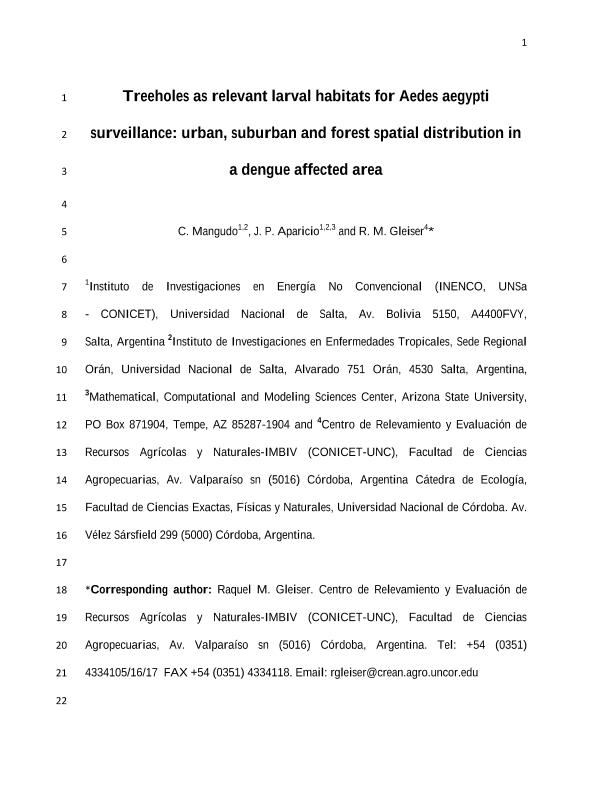Mostrar el registro sencillo del ítem
dc.contributor.author
Mangudo, Carolina

dc.contributor.author
Aparicio, Juan Pablo

dc.contributor.author
Gleiser, Raquel M.

dc.date.available
2017-01-17T21:15:15Z
dc.date.issued
2015-09
dc.identifier.citation
Mangudo, Carolina; Aparicio, Juan Pablo; Gleiser, Raquel M.; Tree holes as larval habitats for Aedes aegypti in urban, suburban and forest habitats in a dengue affected area; Cambridge University Press; Bulletin Of Entomological Research; 105; 6; 9-2015; 679-684
dc.identifier.issn
0007-4853
dc.identifier.uri
http://hdl.handle.net/11336/11520
dc.description.abstract
Aedes aegypti (L.) (Diptera: Culicidae), the main vector of dengue and urban yellow fever in the world, is highly adapted to the human environment. Artificial containers are the most common larval habitat for the species, but it may develop in tree holes and other phytotelmata. This study assessed whether tree holes in San Ramón de la Nueva Orán, a city located in subtropical montane moist forest where dengue outbreaks occur, are relevant as larval habitat for Ae. aegypti and if the species may be found in natural areas far from human habitations. Water holding tree holes were sampled during 3 years once a month along the rainy season using a siphon bottle, in urban and suburban sites within the city and in adjacent forested areas. Larvae and pupae were collected and the presence and volume of water in each tree hole were recorded. Finding Ae. aegypti in forested areas was an isolated event; however, the species was frequently collected from tree holes throughout the city and along the sampling period. Moreover, larvae were collected in considerably high numbers, stressing the importance of taking into account these natural cavities as potential reinfestation foci within dengue control framework.
dc.format
application/pdf
dc.language.iso
eng
dc.publisher
Cambridge University Press

dc.rights
info:eu-repo/semantics/openAccess
dc.rights.uri
https://creativecommons.org/licenses/by-nc-sa/2.5/ar/
dc.subject
Culicidae
dc.subject
Landscape
dc.subject
Phytotelmata
dc.subject
Population Ecology
dc.subject
Vector
dc.subject.classification
Ecología

dc.subject.classification
Ciencias Biológicas

dc.subject.classification
CIENCIAS NATURALES Y EXACTAS

dc.title
Tree holes as larval habitats for Aedes aegypti in urban, suburban and forest habitats in a dengue affected area
dc.type
info:eu-repo/semantics/article
dc.type
info:ar-repo/semantics/artículo
dc.type
info:eu-repo/semantics/publishedVersion
dc.date.updated
2016-12-28T16:25:12Z
dc.identifier.eissn
1475-2670
dc.journal.volume
105
dc.journal.number
6
dc.journal.pagination
679-684
dc.journal.pais
Reino Unido

dc.journal.ciudad
Cambridge
dc.description.fil
Fil: Mangudo, Carolina. Consejo Nacional de Investigaciones Científicas y Técnicas. Centro Científico Tecnológico Salta. Instituto de Investigaciones en Energía no Convencional; Argentina. Universidad Nacional de Salta. Sede Regional Oran. Instituto de Investigación de Enfermedades Tropicales; Argentina
dc.description.fil
Fil: Aparicio, Juan Pablo. Consejo Nacional de Investigaciones Científicas y Técnicas. Centro Científico Tecnológico Salta. Instituto de Investigaciones en Energía no Convencional; Argentina. Arizona State University; Estados Unidos. Universidad Nacional de Salta. Sede Regional Oran. Instituto de Investigación de Enfermedades Tropicales; Argentina
dc.description.fil
Fil: Gleiser, Raquel M.. Consejo Nacional de Investigaciones Científicas y Técnicas. Centro Científico Tecnológico Córdoba. Instituto Multidisciplinario de Biología Vegetal (p); Argentina. Universidad Nacional de Cordoba. Facultad de Cs.agropecuarias. Centro de Relevamiento y Evaluacion; Argentina. Universidad Nacional de Cordoba. Facultad de Cs.exactas Fisicas y Naturales. Departamento de Diversidad Biologica y Ecologica. Catedra de Ecologia; Argentina
dc.journal.title
Bulletin Of Entomological Research

dc.relation.alternativeid
info:eu-repo/semantics/altIdentifier/doi/https://doi.org/10.1017/S0007485315000590
dc.relation.alternativeid
info:eu-repo/semantics/altIdentifier/url/https://www.cambridge.org/core/journals/bulletin-of-entomological-research/article/div-classtitletree-holes-as-larval-habitats-for-span-classitalicaedes-aegyptispan-in-urban-suburban-and-forest-habitats-in-a-dengue-affected-areadiv/1D24EF4EFD0AAC0A5F4C4DFEA09CA25C
Archivos asociados
